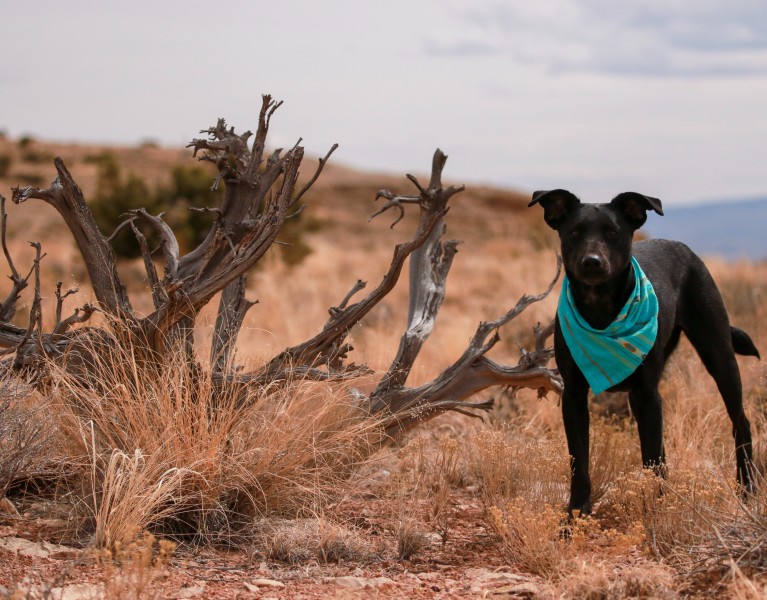
Rattlesnake-Proof Your Canine Hiking Buddy: Vaccines and Avoidance Therapy for Dogs
Table of Contents [Show]
Close your eyes and imagine yourself hiking through a desert arroyo on a warm spring day. Your dog's with you, nosing around the brush and investigating jackrabbit trails. Suddenly, you hear the rattling hiss of a viper's tail.
First, you look for the snake. Then, your head on a swivel, you desperately look around for your pet, hoping there's plenty of distance between the two. You're able to call her to you and snap on her leash before she runs over to introduce herself, and together you wait until the snake settles down in the shade of a stunted smoke tree.
That, for me, was the moment that prompted my journey down a research rabbit hole: What can I do to protect my dog from rattlers? Should I just lock us both in the basement and not go hiking until winter?
Venomous snakes bite tens of thousands of cats and dogs in the U.S. each year. That fact might freak you out as much as it did me, but we do have options. So if your dogs are joining you on your backcountry adventures this season, you may want to consider inoculating them against snake venom, either through actual vaccines, or through avoidance training and basic common sense.
The Canine Rattlesnake Vaccine
Crotalus atrox toxoid, commonly called the Canine Rattlesnake Vaccine, is a USDA-licensed product manufactured by Red Rock Biologics. It's made from the venom of the Western diamondback rattlesnake (Crotalus atrox), which is considered responsible for the majority of rattlesnake bites in North America. According to Arizona-Sonora Desert Museum, the western diamondback is a generalist, found in deserts, grassy plains, forests, rocky hillsides and coastal areas. This species of pit viper thrives in elevations below sea level and as high as 6,500 feet. The Western diamondback's range includes northern Mexico, Arizona, New Mexico, Oklahoma, Texas, and California, and its close relatives range even farther.
Obviously, the vaccine is most effective against venom from this species, but the manufacturer suggests that the vaccine may also provide protection against sidewinder, timber rattlesnake and copperhead venom. The canine vaccine does not provide any protection against bites from the water moccasin (cottonmouth), the coral snake, or the Mojave rattlesnake.
How Well Does the Canine Rattlesnake Vaccine Work?
As opposed to antivenins, which counteract the toxins from a snake bite after the dog's been bitten, the vaccine is administered prophylactically in two or three doses every six to 12 months, depending on your dog's size and the risks of a snakebite. The vaccine is intended to help the dog build up protective antibodies to the specific venom.
As of summer 2018, UC Davis School of Veterinary Medicine doesn't actively recommend the rattlesnake vaccine as part of a pet's routine vaccination schedule. They don't stock the antivenin at their facilities, as they're not convinced that the current vaccine is effective. They also warn that snake-bitten vaccinated dogs still require emergency veterinary care. Here's why:
- Venom chemistry varies even within the same with species.
- The owner may not be certain what kind of snake bit their dog.
- Large amounts of venom in the blood and tissues may overwhelm the dog's existing antibodies, especially if the dog is due for its booster shot.
- A dog's metabolism may affect the vaccination's strength, or the effects of the venom.
- A dog's underlying health problems can complicate a venomous snake bite.

UC Davis may be the most respected veterinary school in the western United States, and while it doesn't endorse the vaccine, it doesn't recommend against it, either. Many kennel clubs and private practice veterinarians still feel the vaccination is worth a shot for healthy dogs in high-risk areas. It's even suggested by the California Department of Fish and Wildlife's rattlesnake fact page.
According to the manufacturer's studies and surveys, vaccinated dogs reportedly experience less pain and have a reduced risk of death or permanent injury.
"Veterinarians typically report that vaccinated dogs bitten by rattlesnakes experience less swelling, less tissue damage and a faster recovery from snakebite than unvaccinated dogs," states Red Rock Biologics' product information website.
It is important to note that all reports are anecdotal, as there have been no scientific studies to back up the efficacy of the Canine Rattlesnake Vaccine. An antibody titer would, in theory, measure a dog's resistance, but since there are no scientific studies that provide a concrete baseline for the titers each species or size of dog requires, results are unreliable. Having said that, these baselines aren't easy to find in species as diverse as the domestic dog.
How Much Does the Canine Rattlesnake Vaccine Cost?
The Canine Rattlesnake Vaccine typically costs about twenty dollars per injection. Small and average-sized canines more than four months old receive two injections 30 days apart, and giant breeds usually need a third round. While the manufacturer recommends annual boosters for most dogs, they encourage boosters every six months for dogs living or working in very high-exposure areas.
Injection costs don't include vet examinations and office visits, so it's a good idea to let your vet know ahead of time that you're looking into the vaccine. Give them time to do their own research if they're not familiar with the vaccine, and to allow them to order the right dosage before your dog's next routine checkup.

Should I Just Go For It and Vaccinate My Dog?
The vaccine is generally accepted among the veterinary community as safe for all dogs (including pregnant and lactating females) at least four months old. Accounts of serious side effects are extremely rare. That doesn't mean that the vaccination is the right choice for you and your dog, but if anecdotal evidence reports no effects at worst, and ease of recovery at best, why not?
Following are examples of dogs that are ideal candidates for the vaccine, provided they live, work, or play in regions Western diamondback country:
- Search & Rescue dogs
- Small breeds
- Dogs that live far from emergency vet care
- Hunting dogs
- Livestock guardian dogs
- Hiking & backcountry companion dogs
- Law Enforcement K-9 Officers
The vaccine may greatly reduce the effects of a serious bite, and buy the dog owner extra time to find emergency veterinary care. This factor is often the tipping point for those who spend a significant amount of time with their dogs in remote wilderness areas or locations lacking veterinary services. I live in rattlesnake country, and my vet happens to be pro-vaccine.
Side note: If you carry an over-the-counter antihistamine for allergies or bee stings, you can give one to your snake-bitten dog to reduce the swelling and possibly help keep him calm while you get him to the vet. Keeping him calm is essential, as it is with humans.

Rattlesnake Avoidance Training
Some dog owners take their dogs to snake avoidance clinics, in which dogs are exposed to live venomous snakes in controlled, real-world settings. Of course, the rattlesnakes' venom glands have been either depleted or removed, or they've had their fangs clipped.
When the dog in training—who's wearing an electronic training collar—encounters the snake, the reptile strikes or rattles. At the same time, the handler activates the shock collar. This training is popular among hikers and hunters, and very unpopular with some.
The problem with the shock method is that negative reinforcement (also called "positive punishment") can actually condition a dog to have aggressive responses to snakes, and possibly other associated triggers. According to veterinarian Dr. Christopher Pachel, competent trainers can effectively, safely, and humanely use this method of avoidance training. He also suggests alternate options for training snake-safe dogs in his Preventive Vet article, "Snake Aversion: How to Train Your Dog to Avoid Venomous Snakes".
Dogs usually identify snakes by smell long before they hear the rattle, and each species has its own scent. Any avoidance training method should expose the dog to multiple venomous snake species. Look for trainers who have access to all the dangerous snakes in your area, and who have earned recommendations from local rescue centers, vets, and kennel clubs.
Rattlesnake avoidance training costs anywhere from $75 to $150 for each dog. Possibly more when the trainer uses multiple viper species.
Good Old-Fashioned Trail Smarts
Snake aversion training works best if your dog has solid obedience skills. You can vaccinate your dog against rattlesnake venom, but the only vaccine for trail injuries is a healthy dose of information.
Learn snake behavior basics, and tips for avoiding them. They seek shade in the middle of hot days, sun themselves in mid-morning, and absorb heat from warm, solid surfaces at night. A snake doesn't have to coil or rattle before striking, especially if they're surprised. If given the option, they'd bail out before escalating a fight, so if you encounter a snake, give it an escape route or, at least, a wide berth.
Once you're on the trail, your dog should be wearing her leash, and you should be wearing wear ankle-high hiking boots and full-length hiking pants. Just as you would avoid sticking your hands where rattlesnakes hang out, discourage your dog from snuffling under brush, scrambling along rocky ledges, or leaving the trail altogether.
I personally feel that avoidance classes and three rounds of rattlesnake vaccinations (including vet clinic fees) are a worthwhile investment of my time and money. When my dog, Lucy, got her shots, I asked my vet what emergency bite treatments costs. She said, "Thousands. That's IF the clinic has the antivenin in stock. I sure don't."
But nothing costs more than the feeling you "coulda, shoulda" done something to help your pooch if she does tangle with the locals.
Featured image by Yuki Dog.


